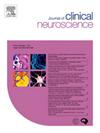非小细胞肺癌脑转移性疾病立体定向放射治疗后的预后因素:一项多中心队列分析
IF 1.9
4区 医学
Q3 CLINICAL NEUROLOGY
引用次数: 0
摘要
背景:非小细胞肺癌(NSCLC)患者经常发生脑转移(BMs),使治疗变得复杂。我们的研究表明,对于接受立体定向放射手术(SRS)治疗脑转移灶的患者来说,体弱程度的增加与总生存期(OS)和中枢神经系统无进展生存期(PFS)的降低有关。借助国际放射外科研究基金会,我们试图扩大这些研究结果的范围,特别是在 NSCLC 领域:方法:我们对四家医疗机构的 193 名(≥1 例)NSCLC 肿瘤患者进行了分析,这些患者至少接受了 3 个月的临床/放射学随访。主要结果包括OS和PFS。根据 mFI-5 将患者分为前期虚弱(0-1)、虚弱(2)和严重虚弱(3 + ):结果:虚弱程度的增加与OS的降低有关(虚弱危险比(HR)=2.49,95 % CI [1.61-3.85];严重虚弱HR=2.65,95 % CI [1.57-4.45])。虚弱前、虚弱和严重虚弱患者的 SRS 后 6 个月生存率分别为 86.1%、69.5% 和 54.5%(P 65 也是较短 OS 的预测因子(HR = 1.78,95 % CI [1.23-2.56]))。我们建立了一个包含年龄和虚弱状态的新型评分系统。得分为 0、1、2 和 3 分的患者的中位生存期分别为 21.1、18.3、8.9 和 5.6 个月(P 结论:我们的结果表明,MFI-5 可预测更短的生存期(HR = 1.78,95 % CI [1.23-2.56]):我们的研究结果表明,MFI-5 是一种很有前景的指标,可应用于护理点,为 NSCLC 患者提供决策支持。本文章由计算机程序翻译,如有差异,请以英文原文为准。
The 5-factor modified frailty index as a prognostic factor following stereotactic radiosurgery for metastatic disease to the brain from non-small cell lung cancer: A multi-center cohort analysis
Background
Non-small cell lung cancer (NSCLC) patients often develop brain metastases (BMs), complicating management. We have shown that increasing frailty is associated with decreased overall survival (OS) and central nervous system progression free survival (PFS) for patients undergoing stereotactic radiosurgery (SRS) to BMs. Leveraging the International Radiosurgery Research Foundation, we sought to expand upon these findings, in NSCLC specifically.
Methods
Across four institutions, 193 patients with (≥1) NSCLC derived BMs with minimum 3 months of clinical/radiographic follow-up were analyzed. Primary outcomes included OS and PFS. Patients were stratified utilizing the mFI-5 into pre-frail (0–1), frail (2), and severely frail (3 + ).
Results
Increased frailty was associated with diminished OS (frail hazard ratio (HR) = 2.49, 95 % CI [1.61–3.85]; severely frail HR = 2.65, 95 % CI [1.57–4.45]). The 6-month post-SRS survival rate was 86.1 %, 69.5 % and 54.5 % for pre-frail, frail and severely frail patients, respectively (p < 0.001). Frailty was not significantly predictive of time to PFS on multivariate Cox Proportional Hazards analysis although there was a trend towards diminished PFS with increasing frailty (median PFS was 18.4, 8.0, and 7.4 months for pre-frail, frail, and severely frail, respectively (p = 0.11). As age > 65 was also predictive of shorter OS (HR = 1.78, 95 % CI [1.23–2.56]). We generated a novel scoring system incorporating age and frailty status. The median survival of patients that scored 0, 1, 2, and 3 points were 21.1, 18.3, 8.9, and 5.6 months, respectively (p < 0.001). The area under the curve of the validation cohort using a logistic regression model was 0.77.
Conclusions
Our results indicate that the MFI-5 is a promising metric with application at the point of care to provide decision support for patients with NSCLC derived BMs.
求助全文
通过发布文献求助,成功后即可免费获取论文全文。
去求助
来源期刊

Journal of Clinical Neuroscience
医学-临床神经学
CiteScore
4.50
自引率
0.00%
发文量
402
审稿时长
40 days
期刊介绍:
This International journal, Journal of Clinical Neuroscience, publishes articles on clinical neurosurgery and neurology and the related neurosciences such as neuro-pathology, neuro-radiology, neuro-ophthalmology and neuro-physiology.
The journal has a broad International perspective, and emphasises the advances occurring in Asia, the Pacific Rim region, Europe and North America. The Journal acts as a focus for publication of major clinical and laboratory research, as well as publishing solicited manuscripts on specific subjects from experts, case reports and other information of interest to clinicians working in the clinical neurosciences.
 求助内容:
求助内容: 应助结果提醒方式:
应助结果提醒方式:


